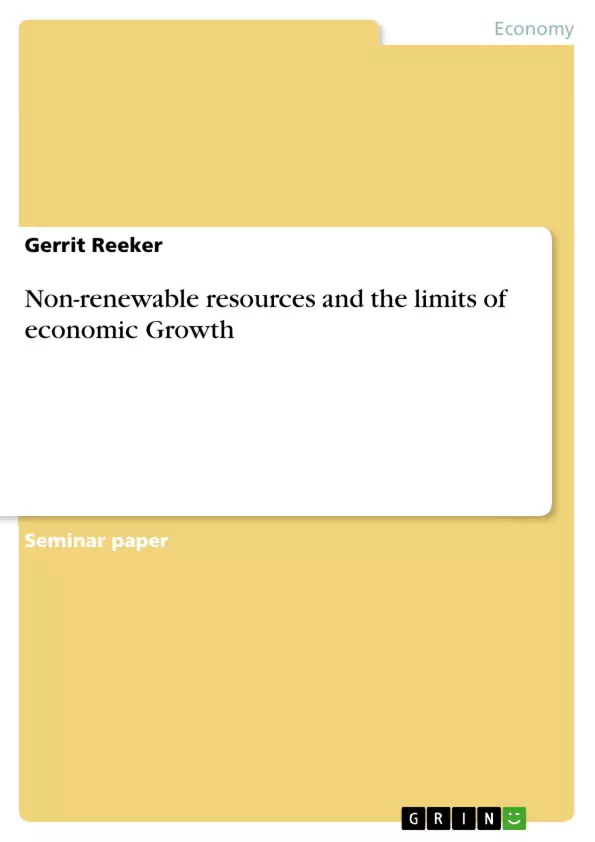In 1972 the Club of rome, a group of economists mainly represented by Donella H. Meadows, published The Limits to growth: The Club of Rome's project on the predicament of mankind, dealinh with a prediction of the world's future in terms of the ongoing exploitation of natural non-renewable resources and their impacts on man's living standards. The book made a deep impression on people's minds and initiated a still ongoing discussion among politicians, environmentalists and economists. limits to growth (Meadwos, 1972) is the center part of this term paper. The current discussion is not just about the impacts of the ongoing exploitation of non-renewable resources; it is about the methods used by meadows as well. the objective of this term paper is to show the main results of Meadows' book and analyze in a critical manner the methods used and their implementations, maily concerning the criticism by William Nordhaus (1992). In order to do so there is an initial need for some general remarks on vocabulary used in the manner of this issue. This means in particular the distiction of growth against development, as well as to answer the question of what is meant by the term sustainability. Afterwards the paper presents some main results of Meadows (1972) concerning predicted pathways of certain indicators representing man's future living standards. following the criticism of Nordhaus (1992) the paper continues with a comparable empirical analysis of resource price development. Afterwards the simple economic growth model by Robert Solow will be examined with respect to fixed amount of land, to show the effect-relationship between economic groth and finite land. Finally there is a summary and conclusion of the elaborated results of this term paper.
Inhaltsverzeichnis (Table of Contents)
- Abstract, Problem Setting and Objective
- Fundamentals
- Meadows' Limits to Growth
- Criticism of Meadows
- Natural Resources in the Solow Model
- Summary and Conclusion
Zielsetzung und Themenschwerpunkte (Objectives and Key Themes)
This term paper examines the main results of Donella Meadows' "The Limits to Growth" (1972), a seminal work that explored the consequences of resource depletion and their impact on human living standards. The paper critically analyzes the methods used in Meadows' work, particularly in light of the criticism by William Nordhaus (1992). Additionally, the paper delves into the concept of sustainability within the framework of the neoclassical growth model by Robert Solow.
- The impact of resource depletion on economic growth and human living standards
- The limitations of Meadows' "Limits to Growth" model and its predictions
- The concept of sustainability in economic models
- The role of natural resources in economic growth models
- A critical analysis of Meadows' methodology and its implications
Zusammenfassung der Kapitel (Chapter Summaries)
The first chapter introduces the paper's objective, which is to analyze Meadows' work and its conclusions regarding the limits of economic growth due to resource depletion. It also explores key terms like "growth" and "development" and defines the concept of sustainability in the context of the study.
The second chapter delves into the fundamental concepts of growth and development, emphasizing the distinction between quantitative growth and qualitative improvement. It also presents a formal definition of sustainability using the neoclassical growth model by Robert Solow, emphasizing the importance of satisfying needs for future generations.
The third chapter discusses Meadows' "Limits to Growth" (1972), focusing on the main results and the factors that limit economic growth, including social and physical necessities. The chapter examines the relationships between available and needed resources, particularly arable land and chromium, through visual representations and analyzes the implications for resource depletion and future resource availability.
Schlüsselwörter (Keywords)
The key terms and concepts central to this paper are the limits of growth, resource depletion, sustainability, Meadows' "Limits to Growth," criticism of Meadows, neoclassical growth model, Robert Solow, natural resources, and economic development. These terms provide a framework for analyzing the complex interplay between resource availability, economic growth, and human well-being.
- Arbeit zitieren
- Gerrit Reeker (Autor:in), 2012, Non-renewable resources and the limits of economic Growth, München, GRIN Verlag, https://www.grin.com/document/269998



